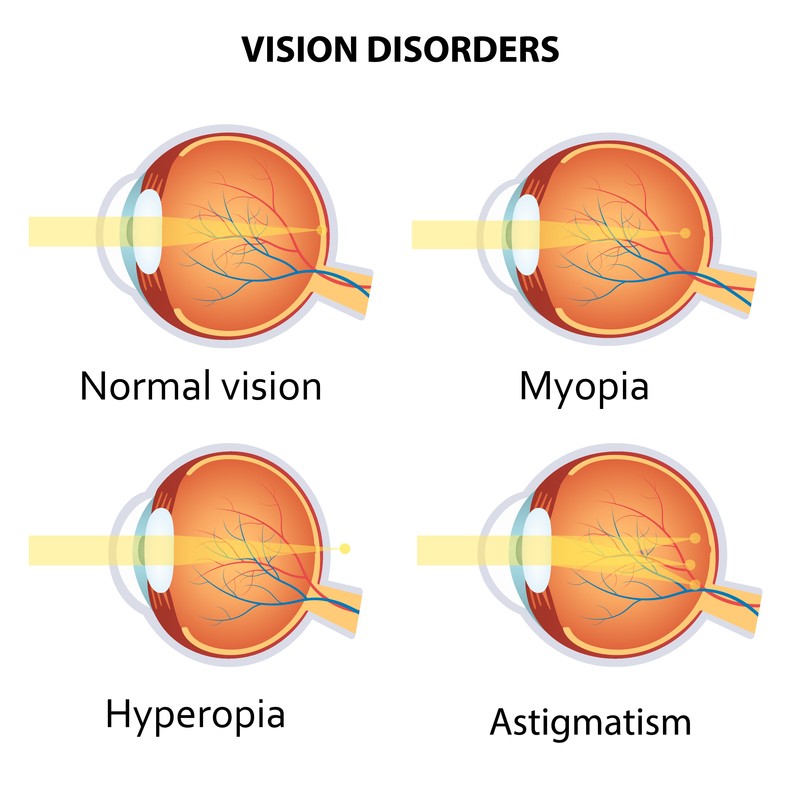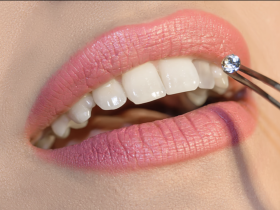A Refractive Error: What Is It?
Refractive error is the result of your eye’s shape improperly bending light, which causes a blurry image. Myopia (nearsightedness), hyperopia (farsightedness), presbyopia (aging-related loss of near vision), and astigmatism are the four primary categories of refractive errors.
Symptoms
- Double vision
- Hazy vision
- Seeing a glare or halo around bright lights
- Squinting
- Headaches
What results in refractive errors?
Any of the following factors, or a combination of them, may cause a refractive error:
• A change in the form of the eye
• A change in the form of the eye
Types of Refractive Error
Ophthalmologists and optometrists at Bharti Eye Foundation can identify refractive error, that is a alternate withinside the form of the eye that reasons imaginative and prescient to become blurred. Refraction, or the bending of light, is what allows you to look.
When you look at an object, the light rays it reflects are refracted via the clear, outermost layer of the eye—known as the cornea—onto an internal lens. The lens then focuses light onto the retina, a layer of light-touchy tissue positioned in the back of the attention.
The retina converts styles of mild into electric indicators and sends those indicators to the mind via the optic nerve. In the mind, those indicators are identified as images of the items you spot round you.
Refractive error happens whilst the eye is not able to bend and focus light correctly onto the retina. Vision can also additionally grow to be blurry, hazy, or doubled, inflicting you to squint and stress your eyes. Other common signs consist of headache because of eyestrain or issue analyzing.
In kids, refractive error can also additionally have an effect on a child’s analyzing degree and feature a terrible effect on standard studying. It may even bring about a everlasting and uncorrectable degradation in vision known as refractive amblyopia. In adults, having blurry imaginative and prescient can be uncomfortable, inconvenient, or even unsafe, specifically whilst using or running machinery.
Ophthalmologists and optometrists at NYU Langone can fast decide the form of refractive error that influences your vision. Children get hold of diagnosis and remedy of refractive mistakess via Bharti Eye hosital at Patel Nagar, Delhi.
Myopia
Myopia, also known as nearsightedness, is the incapacity to look remote items clearly. Objects at a distance look blurred, making it tough to read a faculty blackboard or road signs. Myopia happens whilst refracted mild is centered in the front of the retina in place of onto the retina. This can also additionally arise if the eyeball has an elongated form or if the cornea has an excessive amount of curvature.
Myopia typically first seems in childhood and has a tendency to run in families. Often, myopia can also additionally worsen at some point of a character’s faculty-age and adolescent years, and stabilizes whilst humans are in their 20s.
Most humans with myopia, specifically the ones younger than age 35, are capable of see items up near with out problem. Some humans older than age 35 can also additionally revel in presbyopia as well, which makes it tough to look items near up.
Hyperopia
Hyperopia, additionally known as farsightedness, happens whilst remote items are less difficult to look clearly than close by items. If hyperopia is significant, imaginative and prescient can be blurry at any distance. Hyperopia happens whilst light is refracted in the back of the retina in place of onto the retina. This can also additionally arise if the eyeball is just too quick or if there’s too little curvature in the cornea.
Hyperopia can arise at any age. Some kids have moderate hyperopia that corrects itself by the point they’re adolescents.
Astigmatism
Astigmatism is blurred imaginative and prescient caused through an strangely fashioned cornea. In humans with astigmatism, the cornea is fashioned extra like a soccer or an egg than a sphere.
Light that hits an eye fixed with astigmatism is distorted and refracted to multiple focus factors inside the eye in place of on one focus factor at the retina. Most of the time, humans with astigmatism have issue seeing items near up and some distance away.
There are forms of astigmatism: regular, wherein the eyeball isn’t always round however is symmetrical; and abnormal, wherein the eyeball isn’t always round and now no longer symmetrical. Regular astigmatism is a good deal more common than abnormal astigmatism.
Astigmatism can be gift at birth and is frequently recognized in younger kids. It normally influences each eyes. Sometimes handiest one eye can be affected—for example, if an eye fixed harm consisting of a reduce or puncture reasons scarring at the cornea. Astigmatism can also be caused through a situation known as keratoconus, wherein the cornea thins and begins to bulge outward.
Presbyopia
As you age, you could note that your capacity to recognition up near, specifically whilst analyzing, worsens. Known as presbyopia, this occurs to maximum humans sooner or later after age forty because the eyes’ lenses, which recognition mild, regularly lose their capacity to alter their form to assist you to recognition on close to items.
Presbyopia isn’t always the identical as macular degeneration, that is harm to a small spot, known as the macula, positioned close to the middle of the retina. Macular degeneration normally happens in humans older than age 70 and reasons blurriness in the crucial area of vision whilst you study items close to or some distance. Presbyopia handiest influences the lens of the attention and reasons the complete area of imaginative and prescient to blur whilst you attempt to recognition on some thing up near.
Only a radical exam through an ophthalmologist or optometrist can distinguish among ordinary age-associated modifications in the attention, consisting of presbyopia, and modifications in imaginative and prescient associated with macular degeneration.
Risk Factors
Some humans are much more likely to be stricken by refractive errors than others, including:
- Older humans. Your risk of growing hyperopia will increase every yr till age 70. After 70, your danger of growing myopia will increase. Older humans also are much more likely to increase presbyopia because of the manner your lens hardens over time.
- People with near household who’ve refractive errors. These problems have a tendency to run in households and can have a genetic basis.
Some research have additionally discovered a hyperlink between environmental factors and the improvement of late-onset myopia. These include:
- Not spending sufficient time outdoors
- Use of LED lamps
- Long intervals of “close to paintings,” which means paintings this is executed near your face
- Poor sleeping patterns
Epidemiology
In 2013, the number of people with uncorrected emmetropia worldwide was estimated at 660 million (10 per 100).
Refractive errors are the most common cause of visual impairment and her second most common cause of vision loss. Refractive errors are now rated in DALYs (Disability Adjusted Life Years), an increase of 8% from 1990 to 2019.
The number of people with severe refractive error worldwide he is estimated at 1-2 billion. Rates vary by region of the world, affecting about 25% of Europeans and her 80% of Asians .
Myopia is he one of the most common eye diseases. Adult rates range from 15% to 49%, and pediatric rates range from 1.2% to 42%. Farsightedness is more common in young children whose eyes are not yet fully extended and in older people who have lost their ability to compensate for their accommodation. Presbyopia affects most people over the age of 35 and affects nearly 100% of people between the ages of 55 and 65. Uncorrected refractive error causes vision loss and disability for many people around the world. It is one of the most common causes of blindness along with cataracts, macular degeneration and vitamin A deficiency.
Diagnosing Refractive Error
Ophthalmologists and optometrists at Bharti Eye Foundation refractive errors in adults and kids after acting a complete eye examination. This examination takes region in a doctor’s workplace and isn’t always uncomfortable, even though a few tests—for example, people who use eyedrops that widen your pupils—can also additionally make your eyes experience a chunk unusual and blur your imaginative and prescient for an hour or .
Our best eye specialist endorse having an eye examination in case you revel in blurred imaginative and prescient. You ought to additionally have your eyes tested in case you locate your self regularly squinting or straining to look items which are some distance away, consisting of road signs, or up near, consisting of textual content in a book or on a laptop screen.
In kids, common signs of refractive error consist of now no longer being capable of see studying substances on the the front of a school room or issue analyzing, which can also additionally suggest an incapacity to look textual content up near. Squinting and straining can purpose headaches. Children can also additionally additionally be discovered again and again rubbing their eyes whilst analyzing or looking TV if they have problem seeing genuinely.
Our medical doctors study humans of all a while and diagnose refractive error after performing an eye fixed examination. Children get hold of prognosis of refractive error via Bharti Eye Foundation, Patel Nagar.
Treatment and Drugs
- Eyeglasses
- Contact lenses
- Refractive surgery
Treatments for refractive errors consist of eyeglasses, contact lenses, and refractive surgery.
Myopia and hyperopia are corrected with round lenses. Concave round lenses are used to deal with myopia; they’re minus or divergent. Convex round lenses are used to deal with hyperopia; they’re plus or convergent. Astigmatism is dealt with with cylindrical lenses. Corrective lens prescriptions have three numbers. The first range is the power (magnitude) of round correction required (minus for myopia; plus for hyperopia). The 2nd range is the energy of cylindrical correction required (plus or minus). The third range is the axis of the cylinder. As an example, a prescription for a person with myopic astigmatism can also additionally study -4.50 + 2.50 × 90, and a prescription for a person with hyperopic astigmatism can also additionally read +3.00 + 1.50 × 180.
This Article is posted













Leave a Reply